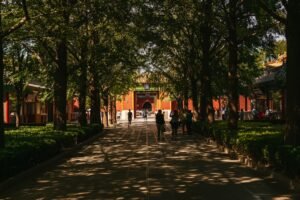

Accelerate Your Norwegian Skills: Summer Courses at NLS
Table of Contents
ToggleIntroduction
Norway’s capital city, Oslo, transforms into a hub of cultural excitement each summer, with extended daylight hours and a dizzying array of festivals. Amid this lively backdrop, NLS Norwegian Language School provides intensive summer courses designed to fast-track your Norwegian language skills, whether you’re a novice or already conversant. In this in-depth article we explore why summer is the ideal season to enhance your Norwegian fluency, why NLS stands out among language schools, and how its comprehensive approach combines rigorous academics with real-world cultural immersion.
If you’re already keen to take your language journey to the next level, feel free to jump ahead and sign up at https://nlsnorwegian.no/norwegian-summer-courses/. Otherwise, read on to discover how Oslo’s summer atmosphere and NLS’s teaching methodology can catalyze your language-learning success.
1. Why Focus on Norwegian This Summer?
- Language in a Global Context
While Norwegian isn’t among the world’s most widely spoken languages, it holds significant value for anyone planning to work, study, or live in Norway. Proficiency in Norwegian can ease your transition into the local workforce, help you socialize more effectively, and enable you to participate more fully in Norwegian culture. - Summer’s Unique Advantages
Learning Norwegian in the summer offers the rare gift of extended daylight—sometimes referred to as the “midnight sun.” This phenomenon allows for more outdoor activities and cultural events, giving you daily opportunities to converse with natives, listen to local music, and pick up new phrases in vibrant social settings. The city becomes a classroom in itself, reinforcing what you learn in your formal lessons. - Quick Confidence Boost
An intensive summer course is akin to a language boot camp: you’ll spend multiple hours per day delving into grammar exercises, speaking drills, and cultural lessons. Although challenging, this high-intensity format accelerates your language acquisition and lets you witness improvements rapidly. By the end of your course, you’ll likely feel comfortable ordering food in Norwegian, reading local newspapers, or even chatting casually with new Norwegian friends.
2. Unpacking NLS Norwegian Language School
- CEFR-Aligned Framework
NLS structures its courses around the Common European Framework of Reference for Languages (CEFR). This alignment clarifies your language-learning path by defining A0–C1 skill levels in reading, writing, speaking, and listening. For instance, a B1-level student can handle most travel and social situations in Norwegian, while a C1-level student is near-fluent, capable of academic discussions or professional tasks. - Flexible Course Options
Depending on your schedule and goals, you can opt for short but intense two-week programs that focus on immediate skill-building or month-long courses that balance rigorous learning with extra time to savor Oslo’s cultural tapestry. Similarly, morning classes might appeal if you have the afternoons free to explore museums, while afternoon classes offer a leisurely start to your day. - Expert Instruction
NLS boasts an exceptional teaching team, many of whom are native Norwegian speakers with years of experience in second-language instruction. Class sizes are kept relatively small, fostering deeper interactions with teachers and classmates. This personal attention and immediate feedback often prove crucial in helping you overcome language-learning hurdles such as pronunciation pitfalls or tricky grammar rules.
3. The Classroom Experience: What to Expect
- Interactive, Student-Centric Methods
Rather than relying solely on lectures, NLS encourages a hands-on approach. You might break into small groups to discuss a short Norwegian video segment or to role-play everyday scenarios like asking for directions or scheduling appointments. Beginner learners focus on foundational grammar and vocabulary, whereas advanced learners tackle debates on current Norwegian societal issues or explore Norwegian literature. - Regular Assessments
Weekly or biweekly quizzes are commonplace, ensuring you remain consistent in your progress. Reading assignments might test your comprehension of short newspaper articles, while listening tests could involve following a brief interview on Norwegian radio. The feedback loop provided by these assessments helps pinpoint weaknesses, whether it’s difficulty with verb conjugations or hesitancy in speaking. - Tech-Integrated Learning
Classroom activities might incorporate modern tools, such as language-learning apps and online resources. Teachers often introduce digital articles, podcasts, or even Norwegian social media content. Not only does this keep classes dynamic, but it also immerses you in contemporary Norwegian usage and culture—vocabulary you might not find in traditional textbooks.
4. Cultural Immersion: Beyond Traditional Lessons
- Field Trips and Excursions
Learning extends far beyond the classroom walls. You could find yourself visiting the Royal Palace, exploring the Viking Ship Museum, or strolling through the Vigeland Sculpture Park. These excursions let you experience Norwegian heritage first-hand, as you read signage in Norwegian, interact with staff, or even enjoy guided tours partly conducted in the local language. - Social Activities
NLS often hosts or directs students to social events that encourage interaction in Norwegian. For example, you might attend a summer barbecue by the Oslo Fjord or join a language exchange evening in a local café. These informal gatherings provide real-life settings to practice conversational skills, joke around in Norwegian, and connect with people from diverse cultural backgrounds. - Local Celebrations
From early June to late August, Oslo buzzes with festivals, from music and dance to food and technology. Immersing yourself in these events gives you a chance to hear Norwegian in a myriad of contexts—stage announcements, menu items, casual conversations. By actively participating, you not only learn new vocabulary but also grasp cultural nuances that language textbooks often miss.
5. Course Levels and Learning Objectives
- A0/A1: Building a Foundation
At the absolute beginner stage, you’ll learn to introduce yourself, ask simple questions, and understand familiar expressions. Grammar basics like noun genders, present tense verbs, and everyday vocabulary form the bedrock of your studies. - A2: Expanding Vocabulary
A2 students start creating more complex sentences and discussing daily routines, family, and personal interests. At this stage, you’ll tackle brief texts and strengthen your listening skills through short dialogues or local news snippets. - B1: Conversational Proficiency
At the intermediate level, you’ll handle a broader range of topics, from describing experiences to expressing opinions on current events. You’ll also practice reading simplified newspaper articles and writing coherent paragraphs. - B2: Confidence and Complexity
B2 learners delve into more advanced grammar—past perfect, conditional forms—and refine their writing with structured essays. They’re also expected to discuss and debate social issues, building the fluency to express nuanced viewpoints. - C1: Near Fluency
At this advanced stage, you’ll handle academic or professional contexts with ease, parse complex texts, and deliver presentations in Norwegian. Fine-tuning your accent, mastering idiomatic expressions, and engaging in abstract discussions become core goals.
6. Achieving Rapid Progress
- Intensity Drives Results
An intensive summer program means regular classes, frequent homework assignments, and continuous immersion in the language. While the pace is demanding, it also means you’re inundated with Norwegian daily. Such constant exposure helps you think directly in Norwegian rather than translating from your mother tongue. - Motivational Milestones
CEFR-based checkpoints give you tangible targets. Perhaps you aim to reach A2 by the program’s midpoint or aim for B1 by the end. Celebrating small wins—like confidently ordering at a restaurant or understanding announcements on public transport—also boosts morale, reinforcing the sense of achievement. - Supportive Peer Network
Your classmates will likely share similar challenges and aspirations. Forming study groups or practice pairs helps you stay accountable. Working through grammar exercises together, practicing dialogues, and sharing cultural insights from your respective backgrounds fosters a sense of camaraderie.
7. Why Opt for NLS Norwegian Language School?
- Comprehensive Curriculum
Rather than focusing narrowly on grammar or conversation, NLS incorporates reading, writing, listening, and speaking into every course level. Cultural components—like excursions and local media—solidify the integration of language and context. - Immersive Environment
From classroom role-plays to real-life interactions in Oslo, NLS ensures you’re consistently practicing Norwegian. The school’s approach caters not just to passive understanding but to active production of the language, a critical step for attaining fluency. - Flexible Scheduling
Morning and afternoon sessions, plus a range of course durations, mean you can tailor your study experience. This flexibility is especially important for individuals juggling work, family commitments, or extended travel itineraries. - Recognized Certification
At the program’s conclusion, you’ll receive a certification that reflects your CEFR level. This credential can significantly strengthen your resume or academic profile, especially if you plan to remain in Norway for employment or further studies.
To see course options and registration details, visit https://nlsnorwegian.no/norwegian-summer-courses/ and secure your spot.
8. Practical Considerations
- Accommodation
Summer is a high-demand season, so it’s prudent to reserve accommodations early. Whether you choose a hostel, shared apartment, or student dorm, living with fellow learners can accelerate your language practice. You’ll often find yourself speaking Norwegian around the clock if you create a supportive environment at home. - Cost of Living
Yes, Norway can be expensive, but careful planning helps. Cooking meals at home, using public transport passes, and looking out for free cultural events can stretch your budget. Some part-time job opportunities exist, but remember you’ll need adequate Norwegian proficiency and the correct work authorization.
9. Stories of Success
- Thomas, Germany
Thomas arrived with a shaky grasp of basic Norwegian, but after a four-week intensive course, he could confidently handle everyday conversations. The immersive nature of the program allowed him to quickly adapt to local customs, and he found part-time work at a café where he continued to refine his speech. - Cecilia, Brazil
Cecilia aimed to enroll in a Norwegian university program that required at least a B2-level proficiency. Through NLS’s targeted curriculum, she achieved B2 in just one summer. She credits the small group discussions and cultural excursions for helping her build real-world competence. - Arjun, India
Arjun joined NLS at the A2 level and progressed to B2 by the end of the summer. Excited by Norway’s tech scene, he landed an internship at a local startup where Norwegian language skills were a distinct advantage, especially during collaborative projects and presentations.
10. Making the Most of Oslo
- Blend Study and Adventure
Oslo’s extensive public transport system makes it simple to explore the city after class. Hike in the surrounding forests, kayak on the fjord, or visit historic landmarks. Each adventure becomes an opportunity to integrate newly learned words and phrases into real-life settings. - Network with Locals and Internationals
Attend local meetups, join hobby groups, or look for conversation circles. By expanding your social circles, you’ll gain invaluable linguistic practice. You might even form friendships that outlast your stay in Norway. - Stay Curious
Curiosity is your best friend. If you see a word you don’t understand—on a billboard, in a brochure—look it up. The repeated exposure to vocabulary in authentic contexts cements new knowledge. Over time, those random words accumulate into a robust linguistic repertoire.
Conclusion
Choosing to enroll in a summer course at NLS Norwegian Language School is more than just an academic decision; it’s an investment in cultural enrichment, professional growth, and personal satisfaction. The combination of an intensive, CEFR-aligned curriculum and Oslo’s vibrant summer scene offers an unparalleled immersion experience. You’ll depart not only with improved Norwegian language skills but also with a deeper appreciation for Norway’s heritage and modern lifestyle.
If you’re ready to take the plunge into an exciting season of learning and exploration, don’t hesitate. Head to https://nlsnorwegian.no/norwegian-summer-courses/ to check upcoming class schedules, fees, and additional details. Let Oslo be your gateway to mastering Norwegian—immerse yourself fully, and watch your linguistic confidence soar.
If you want to learn Norwegian, you can register for classes here. We look forward to hearing from you and helping you become fluent in Norwegian.





